Arts & Entertainment Community
Two In Tow & On The Go: We dove with sharks. It was magical (and a little cold)
IF YOU GO
Point Defiance Zoo & Aquarium’s Eye-to-Eye Shark Dive, Tacoma
Ages: Ages 8+ only — and yes, they check!
Gear: All gear is included. Bring a change of clothes with you to the dive room.
Cost: $95–$125 per person depending on season and membership.
Perks: The shark dive cost includes zoo admission and a dive video (watch our video below)
Tip: Each shark dive has spots for four people per session, via an online calendar reservation system. Book all four dive spots for a private group experience.
More info: https://www.pdza.org/discover/shark-dives
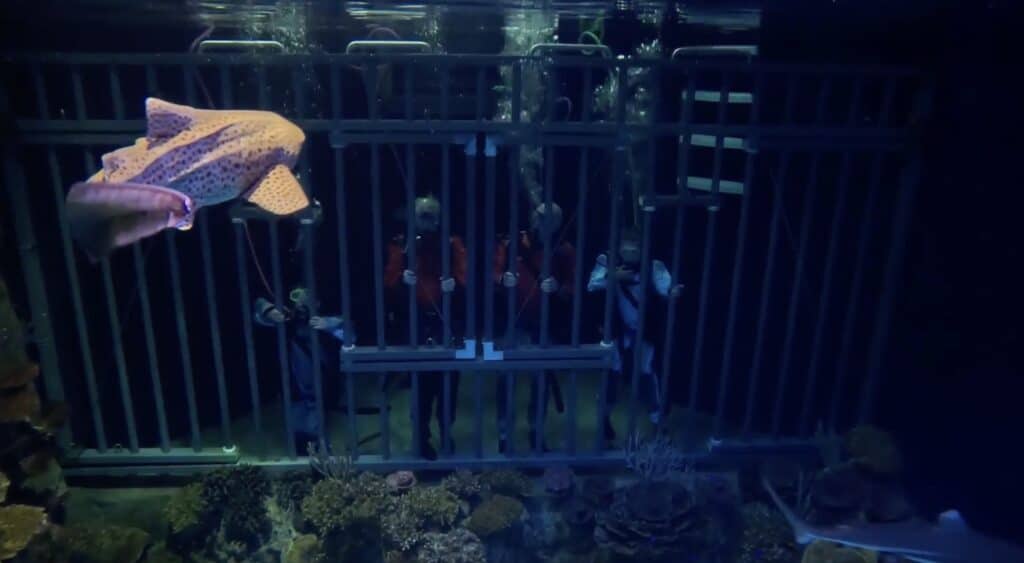
All four of us in the dive cage. Source: Screenshot of video from our dive on June 15, 2025, captured by the PDZA Dive Team.
If you’ve ever wanted to meet sharks eye-to-eye, to feel small in the best possible way, and to show your kids or grandkids how science and adventure can live side by side — then this activity is for you.
Suspended in a cage beneath the surface of a 240,000-gallon tank, I held onto the bars and slowly lowered myself — hand over hand — until my feet hit the base below me. My husband Bowen was already there, giving me the “I’m OK” hand signal the dive crew taught us on the surface. Our two kids, Clara and Wyatt, hovered close in oversized suits and masks and their own little bubbles of wonder. I looked at them and smiled, and suddenly realized that, aside from my own breathing, everything else was … quiet. Not “library quiet.” Ocean quiet. The type of insulated sit-at-the-bottom-of-pool brand of pre-parenting silence I hadn’t experienced in more than a decade. But we weren’t in the ocean, nor at the bottom of a swimming pool. Not quite, anyway.
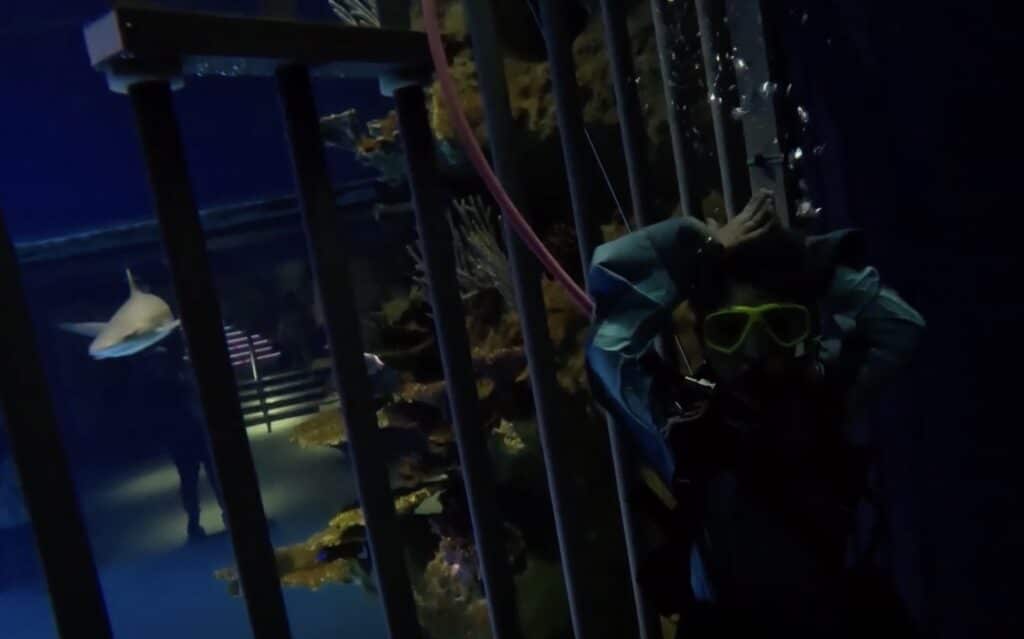
Wyatt is making a shark fin with his hands. Source: Screenshot of video from our dive, captured by the PDZA Dive Team.
We were about 10 feet underwater, secured in a large cage for the Point Defiance Zoo & Aquarium’s Eye-to-Eye Shark Dive in Tacoma. The dive takes place in the Outer Reef tank inside the newly remodeled Tropical Reef Aquarium, located just before the entrance to the Asian Forest Sanctuary. I wrote about that same location in March 2023 for a story about visitor traditions involving a giant megalodon jaw sculpture stationed there, but word on the street is the replica was quietly retired last year. Sad.
Marketed as an add-on that guests can buy for a behind-the-scenes look at the zoo, the shark dive is one of the zoo’s most popular paid experiences since it launched in 2013. Even now, the booking calendar was pretty full when I bought our tickets in May for Bowen’s birthday. An early morning spot for four people, for example, required a reservation few weeks in advance. We ended up booking a spot on June 15, which just happened to be Father’s Day! Perfect.
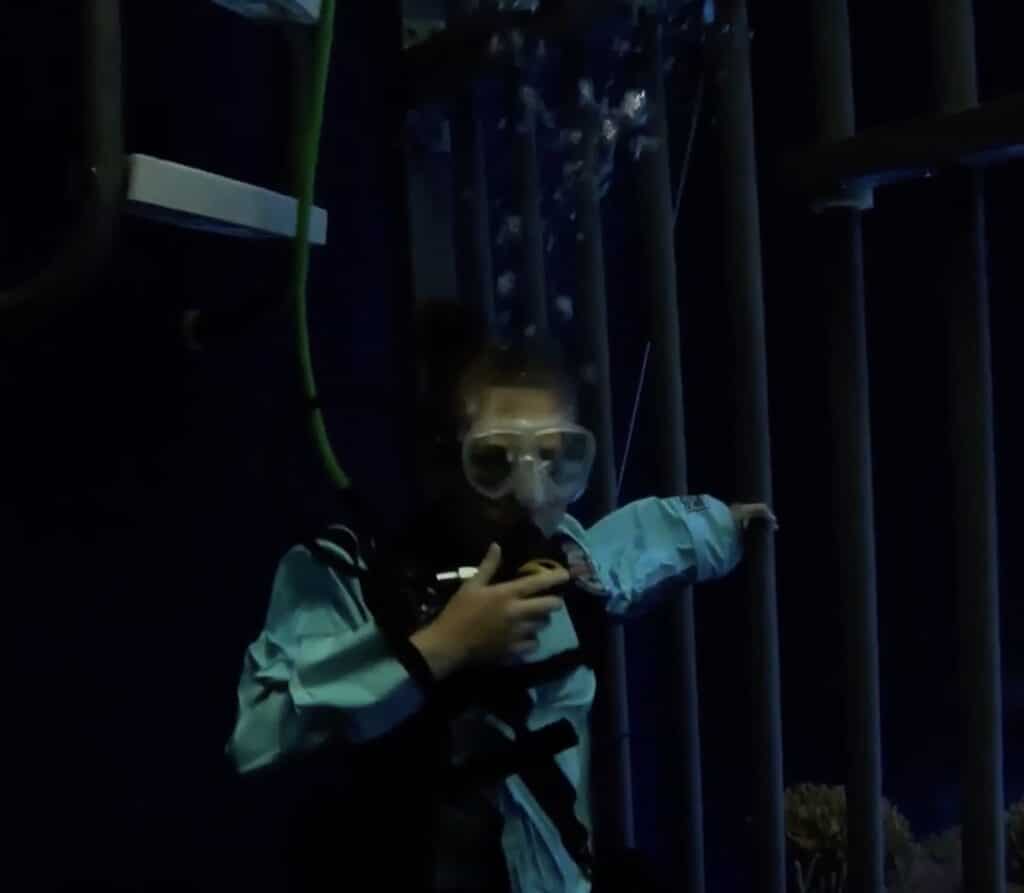
Clara in all her gear. Source: Screenshot of video from our dive, captured by the PDZA Dive Team.
The only time the shark dives weren’t popular in recent years were from 2021 to 2024, when the zoo stopped offering the dives during renovations of the former South Pacific Aquarium. The shark dive also got an upgrade — in accessibility. The program now offers a Hoyer lift for mobility help, inclusive suit sizing up to 6XL and even prescription masks for us nearsighted folks.
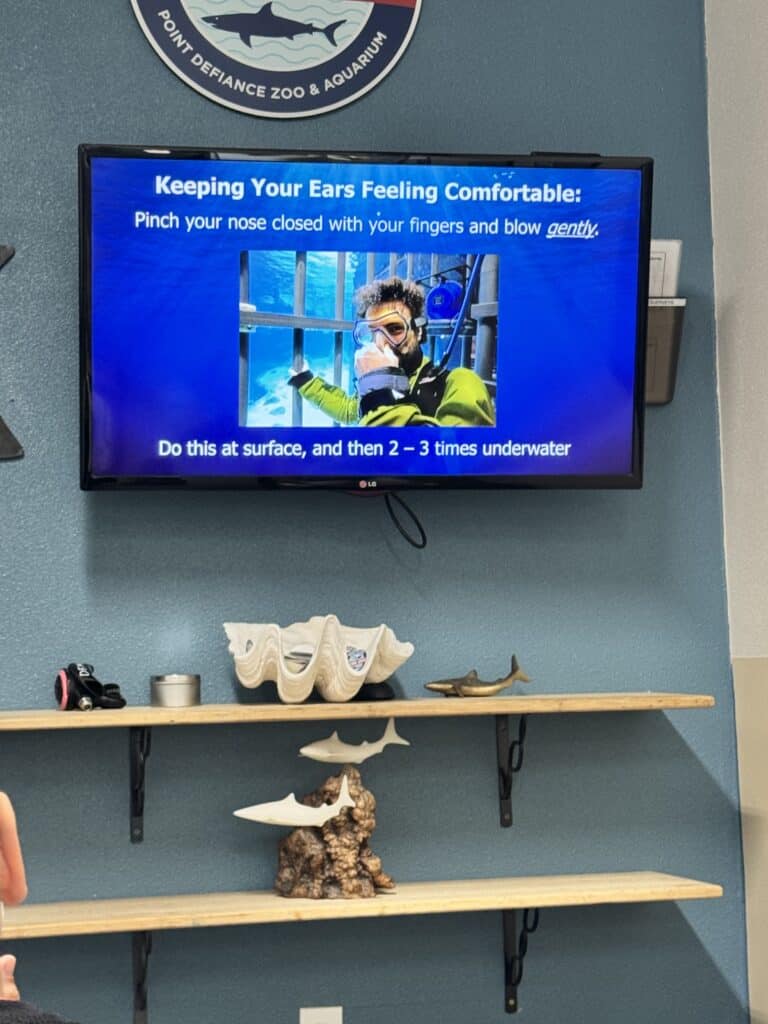
Suit up, step in
The shark dive is a 60-minute session overall. But it’s broken down into segments that end up being about 20 minutes underwater. There’s also time alotted for a safety briefing, conservation talk and suiting up. Entering the water also takes some time. We entered from a back room stationed at the upper edge of the massive Outer Reef tank. As divers, we get our masks, and breathing hose before beginning our descent one at a time. Coiled air hoses and equipment hung nearby and the dive crew offered us steady hands and calm encouragement at the platform’s edge. Just beyond the entry point, movements beneath the water hinted at the awesome underwater world waiting below.

We got some training before our dive in a little classroom area housed above the tank.
The dive may sound a little complicated, but previous diving experience or certifications are not needed for this experience. Heck, not even swimming skills. All one needs* is the courage to don a spacesuit-looking uniform, step into a giant cage, breathe through an air hose, and let yourself be immersed in a place where time is measured not in minutes, but in the slow, steady laps of passing sharks.
As we bobbed quietly in our little viewing corners, zebra sharks, rays and other species swam past us. Lots of other species did, too, but I don’t remember all of their names. The sharks didn’t swim right up to us to investigate. Instead, they more or less just swam right on by like we weren’t even there. That’s OK, I wasn’t even offended. But you know who did notice us? Other humans. Zoo guests waved at us from the public viewing side of the aquarium tank, seemingly cheering us on while we drifted like astronauts in our little box amid a salty reef nebula. Some even asked if we were the divers in the cage once we got back outside!
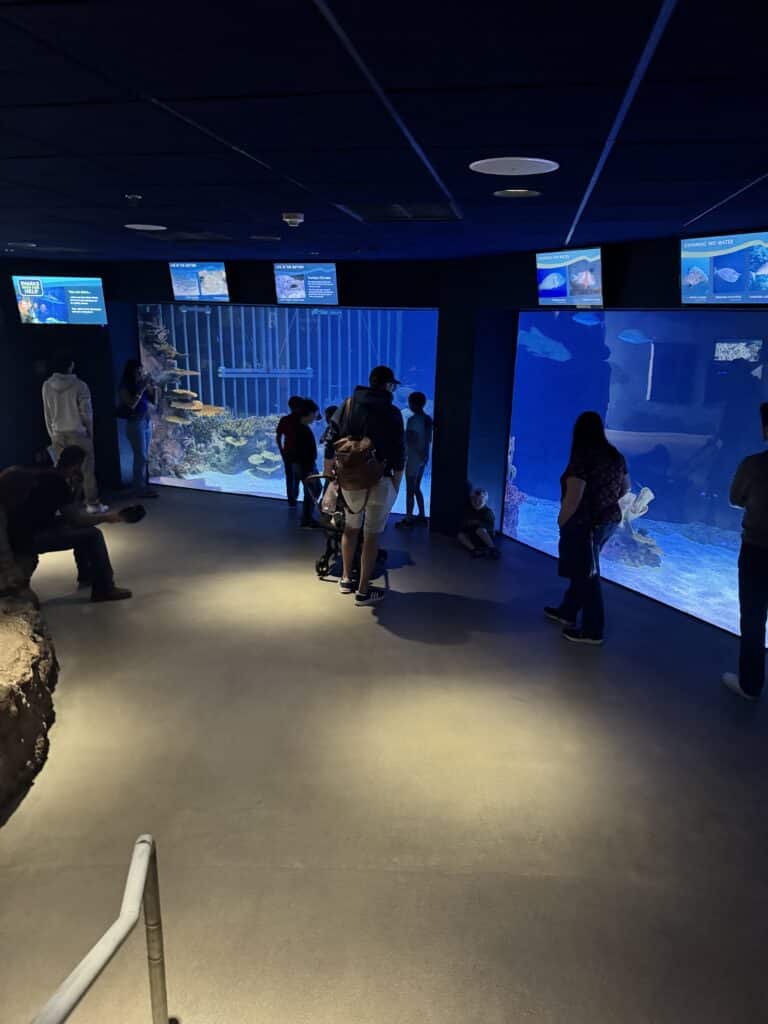
Here is the view of the diving cage from inside the public viewing area to the Outer Reef Habitat. You can see the dive cage bars at left behind the tank wall.
The Outer Reef may be considered warm and tropical where temps reach about 76°F — but somehow we were still cold just 10 feet below the surface. Even Bowen said he was cold, and he was born in Alaska. So our big tip is to make sure to wear a cozy sweatshirt and sweatpants beneath your suit. If you forget to bring some, don’t forget to ask the dive crew about the loaner comfy clothes they keep on hand for divers to borrow while they’re there. The other tip is to bring a change of clothes with you, because, as I mentioned above, that sneaky reef water still manages to seep in through the neck and sleeve openings of the water suits despite their ample sealing.
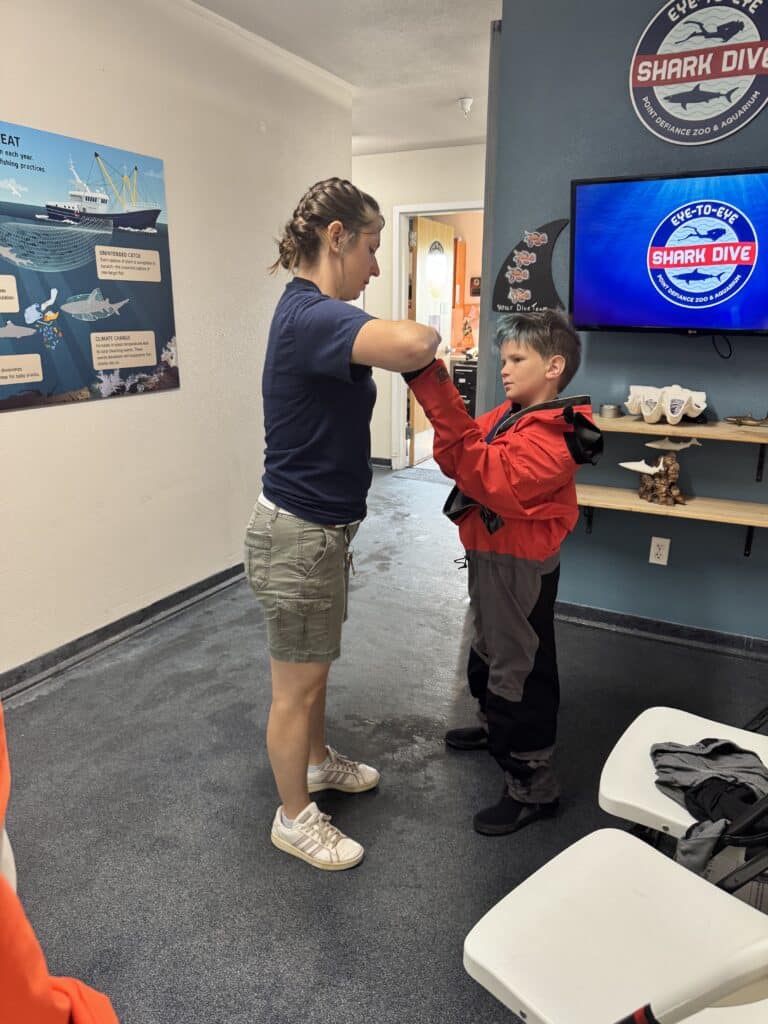
Wyatt suiting up in gear the dive team provided.
Zebra sharks
The shark dive wasn’t just cool. It was meaningful, too. The experience is intentionally designed to spark action and empathy for ocean life and conservation efforts. Before the dive, sitting in a little presentation room, our dive guide told us how sharks quietly keep the ecosystems of marine life in balance through predator-prey dynamics.
But that harmony is in trouble, she said, using the plight of zebra sharks as a prime example of how the global shark trade (of fins, meat and byproducts), overfishing and habitat loss have devastated zebra shark populations worldwide.
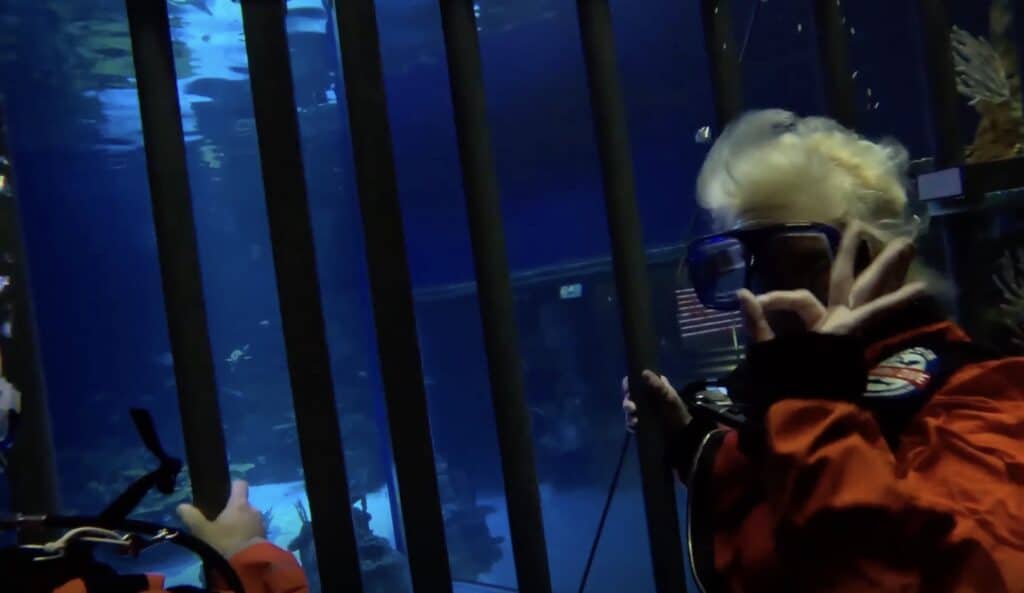
Here I am! Source: Screenshot of video from our dive, captured by the PDZA Dive Team.
Point Defiance’s own zebra sharks — adorably named Peanut, Butter, and Honey — help the team communicate that message. Especially since zebra sharks are easily one of the most visually striking species in the shark world. As pups, their dark brown bodies marked by pale vertical stripes help them stand out like underwater jungle animals. But as they grow, they ditch the stripes for a dotted, golden-tan makeover with scattered brown spots. In the wild, their long, flexible bodies help them glide through the currents and slink into reef crevices in search of prey. Google searches show that adult zebra sharks have two prominent ridges along their sides, small eyes, and a very long tail that can make up nearly half of their total body length!
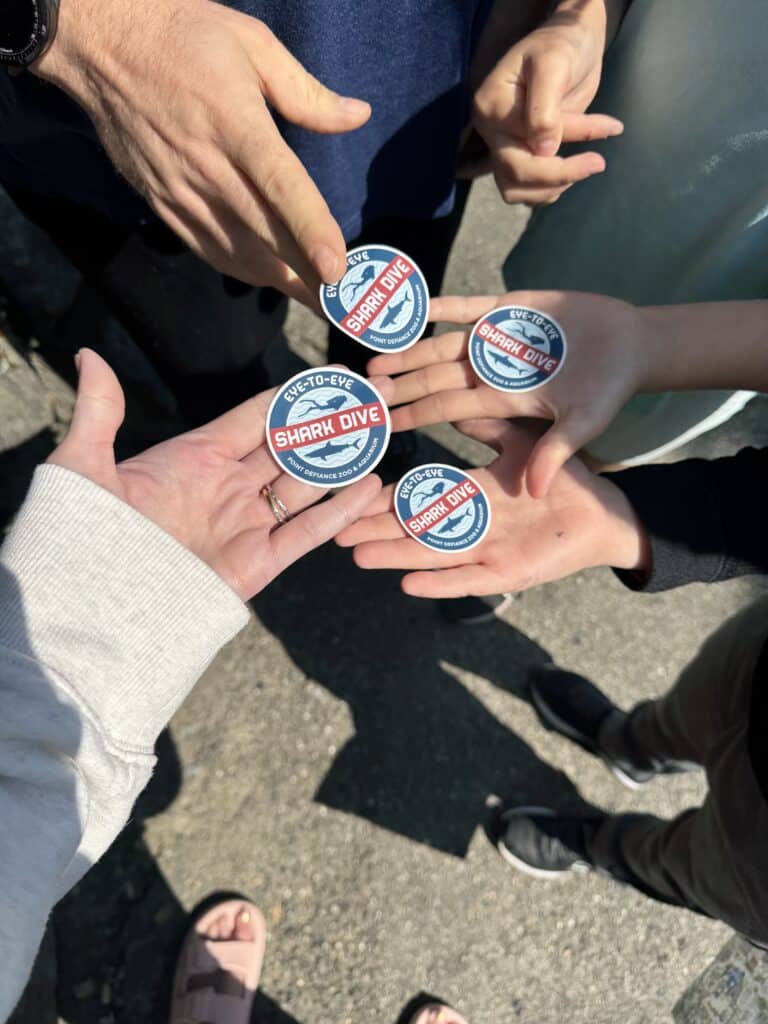
We all got stickers at the end of our visit.
During our dive, an exciting discovery was made. We learned one of the resident zebra sharks deposited an egg in the sand. And it was resting gently on the ground near the glass edge. The egg looked almost alien — an oblong shape encased like a rubbery purse. But it was just what the Point Defiance peeps wanted to see. That’s because the zoo is a partner in a global conservation project called ReShark, which allows Point Defiance to help repopulate sharks in other countries. Working with the Seattle Aquarium, another ReShark partner, zoo-laid shark eggs are transported to Indonesia to hatch, raised in captivity, and eventually be released into the wild.
So, that was our big birthday present to Bowen! And it was a hit with the kids, too. It’s spendy, but overall worth trying at least once.
See ya out there!
*The shark dive listing also requires guests to be in “stable health,” not weight more than 360 pounds and complete an online waiver and medical questionnaire.

@two.n.tow
Tonya Strickland is a Gig Harbor mom-of-two and longtime journalist. Now in the travel and family niche, her blog, Two in Tow & On the Go, was named among the 10 Seattle-Area Instagram Accounts to Follow by ParentMap magazine. Tonya and her husband Bowen moved to Gig Harbor from California with their two kids, Clara (11) and Wyatt (9) in 2021. Find them on Facebook for all the kid-friendly places in and around town.

